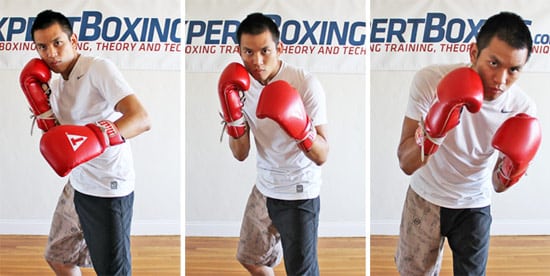
Becoming a slick boxer requires the ability to flow through EVERY POSITION in boxing.
If you’ve ever watched a slick boxer for more than 2 minutes, you’ll see him tilt his spine. First he’ll tilt it one way, then he’ll tilt it another way. His upper body moves like a joystick nearly every minute of the fight.
But WHY should you do it? And an even better question—HOW?
You’re crazy if you still think it’s possible to fight from only one position.
I’ll show you the advantages and disadvantages of the different axes in boxing. Next I’ll tell you how to transition between them. Then I’ll tell you how to transition WITHOUT wobbling off balance.
Keep reading if you want to become a slick boxer.
What are the 3 Axes in Boxing?
The “3 axes” is just a name for a concept I share with fighters. The 3 axes refers to the 3 possible weight distributions in boxing:
- neutral axis – weight evenly distributed between both feet
- forward axis – weight distributed more towards front foot
- back axis – weight distributed more towards back foot
Your axis WILL ALWAYS lean
in the direction of your weight distribution.
When I say “axis”, I am referring to your spine—the axis of your punching rotation.
The important detail to understand is that your axis will tilt wherever you distribute your weight. If your weight is on your back foot, your axis (your spine) must tilt backwards. If your weight is on the front foot, your axis must tilt forward to feel natural.
Sure it’s possible to have your weight on the front foot while leaning back…but that would mean you have to bend your hips forward and that wouldn’t be “natural”.
Great fighters can fight from all 3 axis positions.
Ultimately, you will realize that all boxing stances are created from a difference in weight distribution.
- The hands are naturally positioned to balance the upper body. Notice how fighters that lean back like to drop their front hand?
- The head will tilt towards the foot with more weight.
- The body faces the same direction of the foot with more weight.
1. The hand and head positions are really just a result of your weight distribution.
2. And therefore to have full mastery of your body and truly understand boxing, you have to learn how to move and fight from all these positions.
3. And to fight from these positions, you must first understand how they affect your ability to attack and defend.
All boxing stances are a result
of weight distribution between the feet.
Neutral Axis
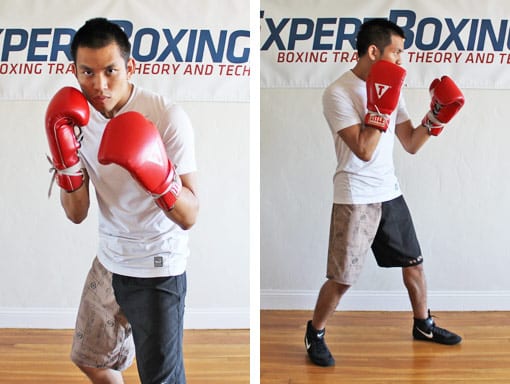
The first boxing stance you ever learned was probably based off the neutral (middle) axis. Standing straight up gives you the best combination of power, defense, balance, and mobility. From here, you can throw and defend against many punches if not all. Both the right and left hands can throw straights, hooks, and uppercuts (that’s a lot of angles!).
The problem with the neutral stance is that
your opponent won’t let you stay there.
No opponent will let you stand straight up in front of him. He’ll be punching you, pushing you, and pressuring you from all angles to knock you off balance or even knock you down. Realistically, you will never be able to stay in one position throughout a fight. You’ll be forced to move around and if you have the skills, you’ll be able to flow and find new opportunities as the fight evolves. For now, just remember that the neutral axis transitions easily to the forward axis or rear axis.

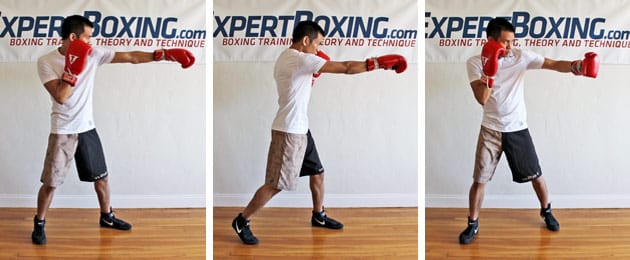
Offensive Opportunities
As I’ve already said, the middle position allows you to throw many punches with perfect form and power. You can throw jabs, crosses, hooks, and uppercuts without losing your balance. At the same time, you’re able to defend well against all your opponent’s punches without worry of losing balance.
Defensive Vulnerability
You are probably most vulnerable to the jab and right hand when you’re standing straight up in the neutral axis (hooks and uppercuts are less likely to reach). You shouldn’t fear jabs and crosses too much since those are the first two punches you learned how to throw and block. Nonetheless you should be very cautious of them.
There is also a 3rd long punch you should be aware of and that’s the left uppercut. It isn’t thrown too often but now you know. As I’ve already said before, the main vulnerability of the neutral axis is that it’s too predictable. Every boxer was trained from day one to attack and defend against boxers that stand straight up. It’s textbook boxing and everybody knows how to deal with it.
Forward Lean Axis
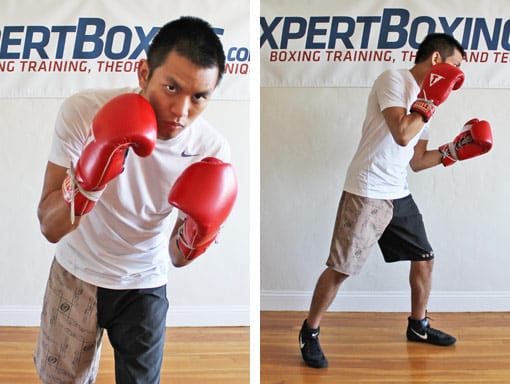
The forward lean (inside) axis is home for the inside fighter. The left hand threatens upwards to the body and head while the right hand threatens downwards with huge chopping right hands. The change of angles can surprise many opponents and catch them off guard especially if you transition while they’re punching. Many counter-punchers will lean forward from time to time for these reasons. The forward lean axis is also useful for holding your ground and keeping an aggressive opponent from pushing you back off balance.

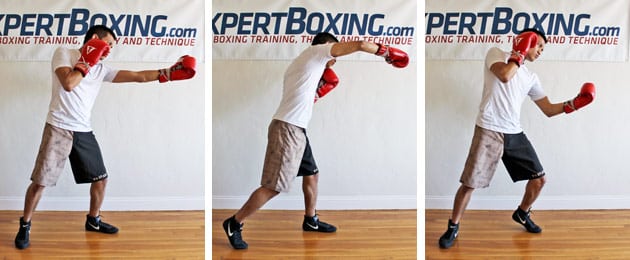
Offensive Opportunities
The left hand can throw upwards hooks and uppercuts to the head and body, whereas the right hand can throw straight rights or overhand rights to the head, and hooks to the body. The inside axis is heaven for the body puncher. Short guys will also like being on the inside for the simple fact that they’re closer to their opponent. The forward lean axis is for pure power punching and causing maximum damage. Do your work and get out!
Defensive Vulnerabilities
This aggressive stance does come with risk and exposure to dangerous punches. For one, your head is right in the way of your opponent’s right uppercut. If he’s got a big uppercut and uses it, this is not where you want to be. You are especially vulnerable to hooks and uppercuts to the head and body. Even if you block the hooks, he can keep throwing it to push you around. Always be ready to evade the left hooks when you’re in this position.
Your biggest risk of all is getting off balance. The number one problem with guys using the forward lean is that they lean forward too much. Your opponents can control your balance by pulling or pushing on your head as they pivot around you and counter. Watch inside fighters like Joe Frazier, Julio Cesar Chavez, etc…and you will see there’s a difference between tilting your axis forward and leaning on your opponent.
Don’t lean forward so much that
you don’t have the strength of your legs under you.
Back Lean Axis
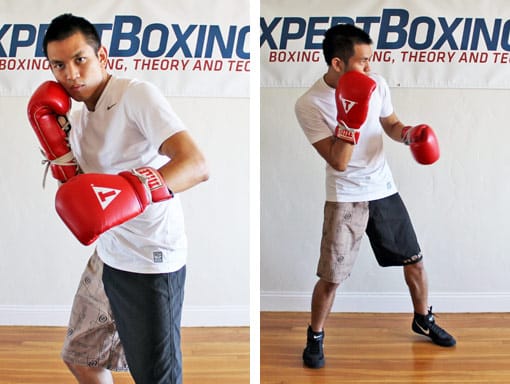
The back lean (rear) axis is commonly used by defensive fighters and counter-punchers. Leaning back allows them to keep opponents away with distance aided by an extra long jab. Should their opponents get past the long left hand jabs and hooks, their right hand can counter forwards and upwards with deadly force on the inside. The rear axis also pulls their head off center making it harder to hit with a right hand. It’s very common to see fighters like Floyd Mayweather block right hands with his left shoulder from the back lean axis.
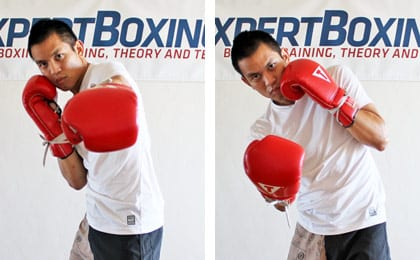
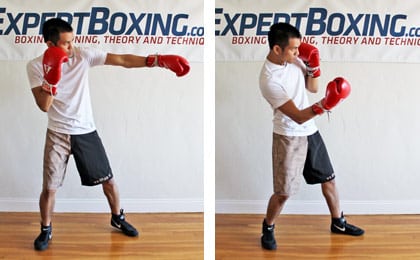
Offensive Opportunities
The back lean axis is perfect for throwing really long jabs to the head and body (think Vitali Klitschko). Should he get past your jab, you can counter him with a big left hook or right uppercut or right hand…or all three. Any time you lean back, he’s going to be tempted to come rushing in so make sure you have that big right hand counter ready. You can also set him up for big counters by rolling your left shoulder to deflect his right hands (like Floyd Mayweather).
Floyd Mayweather blocks a right hand with the shoulder roll, setting up the right hand counter.
Defensive Vulnerabilities
Your two biggest threats from the rear axis is that you get pushed off balance or that your opponent gets past your left hand. You have you be very careful about not leaning back too much that you fall off balance easily. I used to beat fighters that leaned back by pushing their left shoulder. I would just jab or push at their left shoulder until they fell back. The moment they lost their balance, I jumped on top of them or slid behind them and threw everything. You have to be extra careful that you’re not leaning back too much. If you find yourself losing balance, immediately take a step back with your back foot to readjust yourself.
You have to be VERY careful of him getting past your left hand (outside your left hand). He can do that easily by stepping his right foot behind your front foot, or simply by leaning on you in a way that holds your left arm down. Once he gets past your left arm, he can attack with overhand rights, left hooks, left uppercuts, and push you further off balance. All you will have to defend yourself will be a single right hand punch which is easily slipped if he’s prepared for it!
Transitioning Between The 3 Axis
Changing your lean is what boxing is all about! This is the next level of boxing. Every time you slip, you’re shifting into a different axis, evading punches as you attack from different angles. Moving into a new axis is what allows you new punching opportunities that you didn’t have before. You’re also making it harder for your opponent to hit you because you keep moving around.
Changing your axis forces your opponent
to attack and defend at different angles.
Back in your beginner days, you used to attack and defend by just blocking and throwing punches. Or maybe you jumped in and out of range, using your athleticism to attack and defend. Well that doesn’t work at the higher levels. The only way you’ll ever be able to hit someone is to stay within range and outbox them with slipping and multiple punching angles.
3 Ways to Transition to a Different Axis
1. Change axes when you ATTACK
Don’t just keep your head in one place when you attack. Keep shifting your body around as you move your head. This makes it incredibly hard for your opponent to counter while at the same time giving you new angles of attack. You’ll be creating holes in your opponent’s defense as he tries to follow your head.
Move in with a jab, throw a right cross as you lean forward, pull your head out as you throw a left hook, finish with another right hand. Some punches you throw without changing axis, and then with others you change axis with them (especially if you’re expecting a big counter).
2. Change axes when you DEFEND
This is what slipping is all about! Slipping moves your head so that you’re at a different angle each time. By slipping constantly, you force him to punch at different angles as you escape from one place to the next.
If you stay in the same place,
his punches will eventually break through your guard.
3. Change axes when you COUNTER
If you can change axes when you counter-punch, you have officially learned how to box. This is it! Instead of just blocking, change axis as you defend, and throw a counter from an angle he didn’t expect.
If he jabs, drop your to your rear axis and jab to the body. If he throws a right hand, slip forward to the outside (forward axis) and dig a left hook to the body. You can set him up for bigger counters by switching the axis (your position)constantly. Lean back slightly and wait for him to attack. If you see a jab, come right back with a big overhand right to the head, or big right hook to the body. If you see a right hand, drop forward with a big right cross to the body. If he throws a right uppercut while you’re leaning forward, immediately pull out with a big left hook to his exposed head.
Baiting the Counters
Watch how the pro’s do it. They like to start off with a different axis than the one they want to attack from. You might see Ricky Hatton and Miguel Cotto walk towards their opponent with a neutral axis, but everybody knows they want to lean forward and dig hooks to the body. Or you might see Floyd Mayweather throw jabs from the neutral or forward axis, but he leans back the moment someone tries to counter him.
Try to disguise your true intentions by approaching your opponent from a different axis. Be careful not to make it obvious you’re loading up a big counter-punch.
Becoming a Triple-Axis Fighter
One dimensional boxers will typically cling to one axis for the entire fight. (Some fighters will spend the whole time leaning forward. Others might be leaning back.) The bottom line is: sooner or later, they will get exposed. Can you imagine throwing the same punch from the same angle over and over? It stops working by the third try and smart opponents will counter you within a round.
Attacking & defending from the same position every time,
makes it easy for your opponent to defend
& counter you.
Axis Switching Tip #1 – SHIFT FLUIDLY
Multi-dimensional boxers will constantly shift across the 3 axis in fluid motion as they fight. This allows them to be a constantly moving target without actually having to move their feet. They can attack from more angles with more variety of punches, all while staying within range. Some fighters will fight from the front and neutral axis (offensive fighters), or the rear and neutral axis (defensive fighters). I’ve also seen fighters using only the forward and rear axis; I call this being “off-balanced”.
When you move into a new axis, be smart. Don’t just lean forward out of nowhere or lean back for no reason. Don’t make it easy for opponents to learn your movements. Throw a punch to disguise your real intentions. Toss a jab out. Aim it at his shoulder or chest so he’s more likely to block it. Then attack with a quick flurry before you shift into a different axis and throw the real combination.
Now if you are REALLLLLLY clever, you will change axis when your opponent punches. Use the opportunity to move into a different axis when you slip, and then you counter from the new axis. Because you countered from a new angle and a new position, your opponent will be totally unprepared for it which maximizes the chance of a knockout.
Great slipping takes you out of danger
and gives you a new punching angle.
Axis Switching Tip #2 – SHIFT SUBTLY
When you shift to the new axis, be subtle, don’t lean too much!!! The new axis should only be a slight difference. If you lean too much, you become off balance and vulnerable. As long as you have your head at a different angle and have your punches coming from a different angle, you are fine. You don’t need to move any more than that. A forward lean doesn’t have to be drastically different from the neutral axis. The difference is only a matter of inches. Read my guide on Advanced Slipping Technique, PART 1 – Head Movement.
A great boxer can change axis
WITHOUT LOOKING like he changed axis.
As you master the art of changing axes when you fight, you will notice an advantage that goes beyond punching angles and moving defense. Your opponent will over-swing and come off balance when you keep changing your axis. Not only will he not be able to defend, he won’t be able to stand on his own two feet. You will be able to push him around, slip his off-balance counters, and attack him freely.
Using all 3 axis is an advanced boxing skill. You’ll need some smooth coordination, slipping skills, and relaxed movement in the ring. Once you get the hang of it, you will feel a beautiful flow in your boxing movements. Your game rises to a whole new level when you can stay within range and move fluidly across the 3 axes avoiding punches while attacking from deadly angles. You can practice transitioning through the 3 axes in shadowboxing!
Axis Switching Tip #3 – SHIFT USING ROTATION
The easiest way to shift your weight from one foot to the other without leaning off balance is to rotate your spine. You can keep your spine right at the center and then pivot your entire body (including the feet) so that you face towards the front foot, or the back foot, or somewhere in the middle. If your spine leans over, it should be because your weight fell towards one foot, not because you bent at the waist. Keep your waist straight!
There are so many fighters who learn this new tactic and do it ineffectively by trying to tilt their spine from the waist. Leaning forwards or backwards from the spine doesn’t do anything except put you off balance and make it harder to transfer power from your legs to your hands. In reality the words “lean” or “tilt” are used to help you visualize the concept. The less lean or tilt you have, the better.
My Favorite Triple-Axis Fighters
It’s not common to see fighters fight on all 3 axes, but they do exist. Here are my favorites:
- Pernell Whitaker – the way he fights, it’s like he has 5 axes!
- James Toney – slickness beats athleticism anyday!
- Miguel Cotto – watch him stalk and box from all 3 axes!
- Floyd Mayweather – sometimes leaning forward, sometimes leaning backward, and at times deadly right in the middle. He might be leaning, but he’s never off balance!
- Joan Guzman – he’s inside, he’s outside, he’s everywhere!
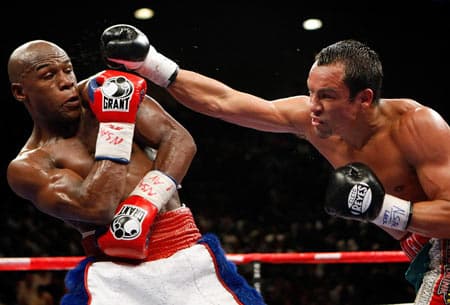






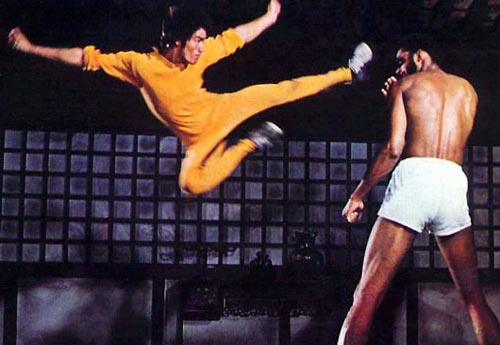
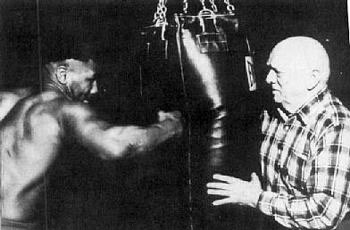


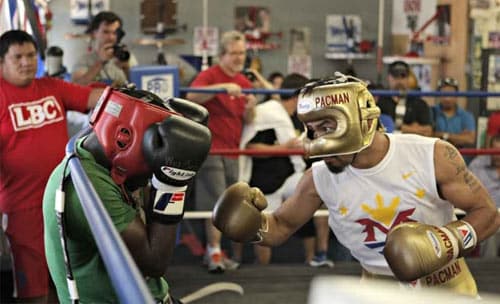
Excellent article…I prefer using the rear axis,my opponents finds it hard 2 connect with a solid punch cos I sumtyms mix it with the shoulder roll…thnx alot
Artur Szpilka… a perfect example of 3 axis boxing, looks and moves like a lightweight compared to some heavyweights and well worth a watching!
I just looked him up and wow, what a good boxer and very mobile for a heavyweight!
Yeh, (Szpilka) hes definitely my favorite boxer at the minute and has been since my polish friend told me to have a look at him, think he’s 12 9 0, and actually fighting this Friday night on the undercard of Molina v Spinks, and is taking on Mike Mollo and is then lined up to fight fellow unbeaten Krzysztof Zimnoch just 3 weeks later, think I’ll be having a look at those 2 fights!
In his last fight against Jameel Mc Cline, he had his jaw broke in 2 places in the 6th round, and went on to win it after 10, to me that says alot on its own and especially that hes got heart, plus I think we can rule out the whole glass jaw thing too…
Definitely liking his style!
ps, great site Johnny, and yet again another great article!
I did not know about his broken jaw in his fight again McCline. I’ll definitely watch out for this guy. I like his style.
interesting article but I am little confused on the offensive part of the rear axis
If you’re farther away from your opponent wouldn’t you have to step to hit them? Or is the rear axis used for countering purposes? Any example of a fight I can watch to see this more also?
You use whatever position is necessary. Messing around with your axis doesn’t mean leaning off balance. At most, you’d be a few inches off center so there’s no reason why you would lose all movement capability.
Now yes, if you’re farther away then that means you have to invade your opponent’s space to hit him or he has to invade your space before you can reach him. The general idea is to switch to the axis when it’s convenient and makes sense because it fits the situation. If you want examples, look up the fighters I mentioned.
Johnny, I have a question. If you master perfect punching technique, then why do I see so many good boxers vary the technique or not throw it “perfectly”? For example, a boxer can throw a strong straight right, but the heel will hardly turn at all. Do you reach a point where you are able to void some things, still keeping good balance, therefore the punch is still very effective? That’s always been my biggest question. If you’re taught to do it perfectly, then how come it’s done with so many errors, but remains just as effective? Like keeping the hands down, not turning the heels, being off balanced.
That’s the difference between experienced vs in-experienced. When you have the understanding, you can change your technique to fit the situation. It won’t fit the “textbook technique” anymore but it will be so much more effective because you altered it perfectly to fit your strategy.
Beginners on the other hand…have little understanding, have little strategy. Their level of fighting is very low and basic…and so then the technique for every move matters a lot because their fighting is all about the punching. Whereas a high level guy’s fighting is all about the movement and baiting.
That makes a lot of sense. I know you’ve heard before, “he’s a good puncher, but not a good boxer”. If you can out punch your opponent, then doesn’t that make you the better boxer? For example, Leo Santa Cruz doesn’t use much footwork or feints, but he stays in range with a high guard and is able to dominate that way. That seems to be the most efficient way to box, not that I have any right in saying so, but it’s fucking awesome. Can you do an article on that clash of styles, and break it down. That’d be a fun read.
Johnny, another great article. Thank you!!
This is off-topic, but I think you should make a testimonials section here in expert boxing where people can post pictures or videos to show the amount of progress they have attained through your help haha 🙂
I also disagree with some of the things you say, but overall, your articles are some of the best one can find on the internet or anywhere else for that matter. We can easily see your love for the sport. It’s also great that you are diligent in posting new content all the time.
I used to be a bodybuilder, and started looking into boxing just a month or so ago because my girlfriend wanted to try it. After finding your website and being open-minded enough to try out the stuff you were teaching(even the article against lifting weights so much), I’m really impressed by the results I’ve gotten even in a short period of time. I don’t just box though, I alternate between boxing and doing muay thai, but almost all of your articles still prove relevant, useful, informative, and even just plain fun to read up on.
I hope you will always have the time and inclination to help out people who might be interested in getting into the sport too, or just want to learn more about it. If my move to the US ever goes through, I’ll make sure to drop by your gym to see you in action personally 🙂
Thank you for the kind words, Arthur! I was so inspired by your suggestion, I made the page right away:
https://expertboxing.com/testimonials
You can be the first one!
awesome! 🙂 I just noticed your reply now, but I will definitely post some stuff when I can! You’re really doing an exceptional job helping everyone who wants to get into the sport.
Johny do you think being 18 years old is too late to become a pro boxer? Because i LOVE it. But im afraid i might have started to late or that I’m too old to even dream about going pro 🙁 what do you think? Great article by the way!
hey man it’s never too late…I’m 28 and just getting into boxing. I can go pro if I want to. You have plenty of time. Anyone can go pro..but if you are good enough to be a champion, that is the question..
18 is still pretty young. if you’ve enough dedication, drive and talent, I’m sure you can make pro in a year or two!
Not too late.
Bernard Hopkins is damn near 50 and still fighting. If you live a good life you have more than enough ime.
Yeah, i did a little more research and was suprised at how many pro boxers, had a late start and some of them went to become very succesfull!
Ken Norton: 24/25 right after serving in vietnam
Rocky marciano: 24, only punched a heavybag before
Sonny Liston: 19 or 20?
Tarver: Messed around with boxing at a young age, quit, sold drugs and had a baby, got back into boxing in his 20s to go pro
Clinton woods: Got into boxing in his early 20s because of years in the pubs drinking got him fat, he just wanted to lose weight at first.
Mahammad Qawi: 25, straight out of prison went to joe fraziers gym
Sergio Martinez: Started boxing at 20, and turned pro age 22.
Hopkins: 18
Cintron: 19
Earnie Shavers: 22
Nigel Benn: 18
Anthony Mundine: 25
So i guess its never too late!
Thank you for this info, Erick! Very inspiring to see so many fighters start in their college years.
this article covers such a huge part of boxing. left in awe, its put together phenominaly.
my coach is using your website as a tool to increase our boxing IQ for all our fighters. its mandatory that we read your articles now, like homework…except alot funner
hahaha that’s cool of your coach!
I agree, I want to get to shake Johnny’s hand in person someday just to really thank him for the astounding job with this website.
That’s awesome, Thair! Wow. I gotta post up more advanced stuff for you guys. I know you’re beyond most people’s level right now.
hands down.. one of the most epic and informative articles.. Johnny you are the best at what you do.. others are just trying to copy. You deserve a PhD in pugilism. This is the only site that actually teaches me something of value. Keep up the good work!
Mr, Johnny you truly are a boxing genius, this is one nice article also the 1-1-2 combo, i might visit the gym tomorow and try this. Your articles impresses me all the time 🙂 very well written
Thanks don! Let me know how it goes for you. The big thing to pay attention to is how each axis affects the trajectory of your punches.
yes sir, i sparred with my coach..with new angles, it means i have new punches. and it increased my probablility of hitting my coach, but the thing is when i had found a direct hit, i didnt push through with the punch; i stopped 1 inch before actually hitting him, is this correct? i just dont want to hurt him. but when i spar with lesser skilled guys i let them punch me but they dont connect.
I don’t know what you guys are doing but generally, I connect with my punches when I’m sparring.
Thanks Johnny, very useful tips. 🙂
Ken Norton is a good example of back lean axis…great read.
im definitely going to give this a try, but i also tried your “jab with head movement” and seen your closing the distance on youtube, but when i jump into range i always seem to get hit and they move, how can i fix this problem?
You’re jumping from too far. Try leaping in only from inches away, not a whole foot away.
Thanks Johnny! That makes alot of sense, When you change your axis, do you shift weight so its actually more weight on one foot ,or just put more weight on one foot so your weight is even50/50 when you tilt. Thanks!
The weight has to be more on one foot when I shift my axis (with a straight back). Otherwise, I’d be doing an awkward bend at the waist or back.
Thanks johnny!. Great lesson on awareness defense i’ve become a boxing nerd reading your articles. My question is about your article on the 4 parts of defense if certain defenses have an advantage over other defenses i.e footwork vs awareness and counters?. also I know that juan miguel martinez and more so roy jones jr are said to have great footwork defense. Do you know any footwork fighters i could watch?
Watch everybody. Mayweather, Cotto, Jones Jr, Ali, Whitaker, Toney, etc.
hi johnny i know i havnt written in a long time i have been busy but hay thats life.
to me this is a lot like driving a car like where you are learning the three point turn and MSPSL dont you think for a thing like this to be practical a study guide should be drawn and the information made more clearler simpler relevent to the point and concise?
I’m always trying to make it easy.
what do u do when ur fighting a person bigger than you and more powerful ?
Probably have to move a lot, more head movement and more footwork.
Hey Johnny. I read your 2 legged punching article and wanted to clear something up. It had an image showing that leaning forward while throwing a cross was a 1 legged punch. After reading this article it looks like a punch on the forward axis would turn into a 1 legged punch. Does that mean it has less power than a punch from the neutral position?
EXACTLY!
Which is why you lean forward or backward as little as possible to minimize the one-legged effect.
Thank you for this article and all of the effort you put into your website and videos.
Can you use head movement when leaning forward or backwards even though you body weight isn’t neutral?
You most certainly can. Many fighters like James Toney and Pernell Whitaker have done it. I don’t recommend it for beginners because they don’t know how to work their way back into neutral position and end up being stuck off balance and vulnerable.
Hi johnny “………….excellence article you always have great information but this might be your best.vitali klitchko fought very much how you describe in this article ,and he hardly ever lost rds .watch the fight with chris arreola were he would lean into to punch and score ,exit with a few jabs switch back to middle or lean on back foot to safety and and start again all the time hardly getting hit or having to move his feet,
.he a example that it’s not nesscary to have great speed or fancy foot work to be a champion when you can fight like this.one time I even tried to describe what klitchko was doing on this wb site but I couldn’t describe it as well as you did any way great work hope you keep it up thanks
I’m a big fan of the Klitschko brothers. Thanks for the comment, Jerry.
I’m studyng this article and shadowboxing these movements for 2 weeks and going to try it in sparring today.
I know, I am going to get hit a lot till learn it perfectly but so be it ! Boxing is fun 🙂
Which one was mike tyson?
I mean, which axis did mike tyson use?
I mean which axis did mike tyson use?
Hey Johnny! Great article 🙂 I was curious, with a more square stance and peekaboo style, wouldn’t the axis change left/right instead of front/back?
Having all of these available depending on situation would be a great tactic to confuse your opponent in my mind. Hybrid Philly Shell/Peekaboo depending on appropriate situation.
Forward/back axis for long range game and counter punching, peekaboo for closing the gap/mid range fighting. Transition between to two. What you think? =P
Thanks,
Joshua